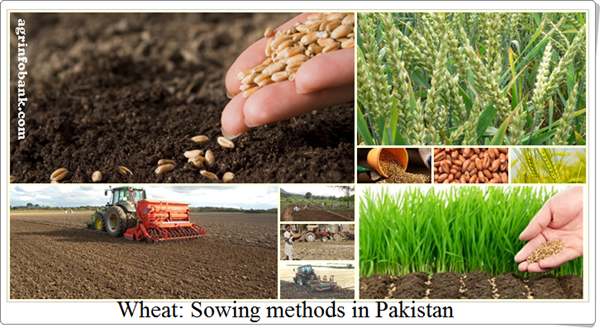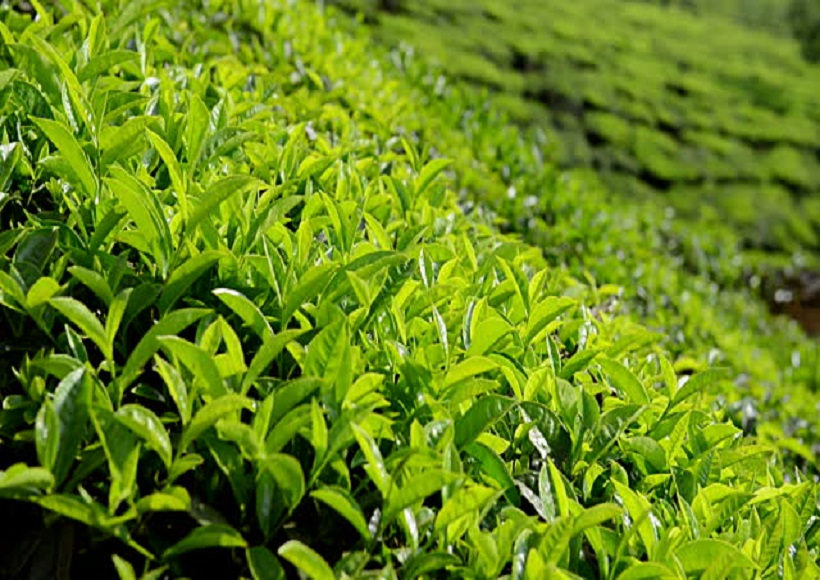Wheat is the largest grown grain crop and main staple food in Pakistan. It is cultivated on slightly more than 9 million hectares with average yield 2600kg/hec. However, progressive farmers are able to get up to 5000kg/hec. Various types of constraints are responsible for the low yield. It can mainly be attributed to poor quality of seed , broad cast method of sowing, late sowing, lack of irrigation water.
Wheat is sown by four methods:
1. Broadcasting: In this method the seeds are broadcast and then worked in by harrowing in order to cover them. However, the seeds are not uniformly distributed in the field. This method of sowing is very insufficient and should not be encouraged. Germination of broadcast seeds is relatively poor and the plant stand is often irregular. Wastage of seed also results because most of the seed is left on the surface where they can not germinate and may, therefore, be picked up and eaten by birds.
2. Behind Local Plough: A majority of farmers uses this method. This method consists of dropping the seeds by hand into the furrows that have been opened with local plough. When seed is dropped in furrows by hand, it is called ‘kera’ method and when it is dropped through a Pora or Nai or Hazara a special attachment with local plough it is called ‘Pora’ method. In this method seeds are dropped of at a depth of 5-6 centimeters and germination is satisfactory.
3. Drilling: In this method seed is sown by seed drill or ferti-seed drill. With the help of this implement seed drop at depth and results in uniform germination and regular stand. Seed bed should be fine and well leveled free from clods and weeds for the use of seed drill or ferti-seed drill. Seed drills are easily available in the market. They may be either bullock driven or tractor driven. Ferti-seed drill should be used wherever possible to ensure uniform depth of sowing, proper placement of fertilizers and good germination.
4. Dibbling: This method is used in case where supply of seed is limited. Sowing is done with the help of a small implement known as ‘Dibbler’. It is a wooden or iron frame with pegs. The frame is pressed in the field and lifted and then one or two seeds are dropped by hand in each of the hole. It is not a common method because it is a very time consuming process.
5. Zero tillage technique: This new method is used in Rice-Wheat cropping system where showing of wheat is delayed beyond 25 November. Sowing is delayed due to multiple reasons, viz. preparation of field, uncertain rainfall and rice harvesting with traditional method. Out of these, the field preparation is one of the most important reasons, which causes delay in wheat sowing. Puddling in transplanted rice creates a hard pan in the field. After harvesting of rice crop , field requires at least 6-8 tillage operations in ploughing and harrowing for sowing of wheat, in which generally 10-15 days are required for proper field preparation. Yield of wheat decreases at the rate of 30 kg per hectare per day after 25 November sowing.
A Zero-till-ferti-seed-drill machine has been developed at G.B.Pant University of Agriculture and Technology, Pantnagar by which direct sowing of wheat is done in Rice field without ploughing. This helps advancing the sowing of wheat as the time required for field preparation is saved. Zero-tillage can be adopted with following preparations.
-
At the time of sowing there should be proper moisture in the field.
-
Rice should be harvested near the ground and the left over stubble should not be more than 15 cm in height and field should be free from weeds.
-
At the time of sowing the seed-drill should be lifted up or lower down very slowly to avoid clocking of furrow opener by soil, otherwise seeds and fertilizer will not drill in the furrow.
-
Seed should be treated with vitavax or Bavistin at the rate of 2.5 g/kg of wheat seed. Seed rate should be 140-150 kg/ha (20-25% higher).
-
Sowing depth should be maintained about 5-6 cm.
-
Light planker may be used behind the zero-tillage machine.
-
After sowing by Zero-till-seed-drill, other package of practices remain the same as in other methods.
The Zero-till-ferti-seed-drill has knife type lines in place of shovel type and is suitable for sowing under Zero-tillage conditions as well as conventional field preparation. The lines are fitted at a distance of 20 centimeters and have a provision to shift by 2.5 centimeters on either side. The machine is fitted with 2 boxes, one for seed and the other one for the fertilizer. On each box, lever is provided along with locking bolts and marking to get known quantity per hectare. Seedling depth can be manipulated by adjusting two side depth wheels with the help of screw bolts. Front driving wheel is provided with a groove to adjust as per requirement. A wooden platform is provided to keep a man to monitor the chocking of seed and fertilizer tube. Zero-tillage machines are provided with two lower link pins and a lift patti to attach the machine with tractor.
Sources:


